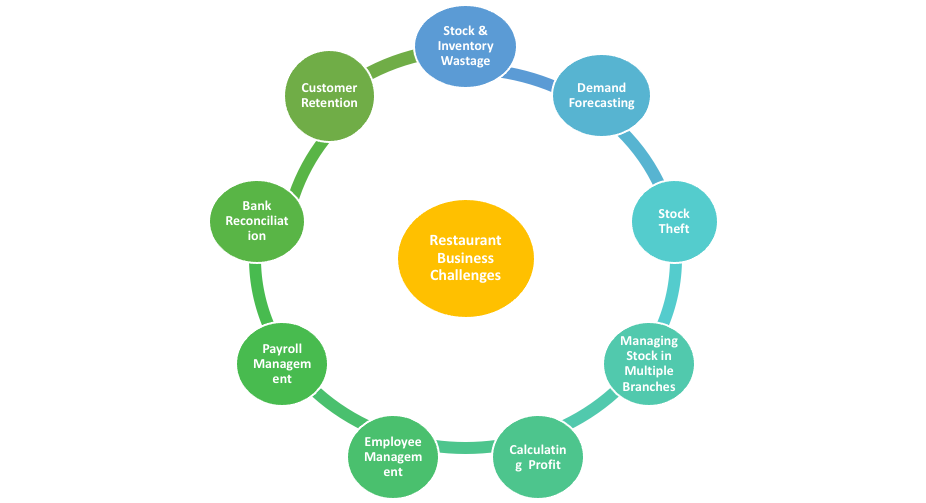
In today’s digital-driven world, the survival of the restaurant industry depends on its ability to adapt to the changing landscape. With the ongoing pandemic, traditional dine-in experiences have been replaced by delivery-based and app-based services. To thrive in this new environment, restaurants must embrace digital advancements and implement robust management systems.
Every restaurant owner faces a unique set of challenges on a daily basis. From demand forecasting to inventory management, order fulfillment to customer satisfaction, there are countless bases to cover. As the demand increases and scalability becomes a priority, these challenges become even more complex. To simplify their workflows, restaurant owners need an end-to-end management system that can address these challenges effectively.
10 Challenges of Running a Restaurant Business
Apart from the obvious challenges of meeting demand and managing inventory, restaurant owners must navigate through the complexities of hiring the right staff with the necessary skills. They also need to focus on labor and time management, as running a restaurant business is not just a job but a lifestyle. With so many challenges to juggle, it’s easy to become overwhelmed.
Let’s take a closer look at some of the common challenges faced by restaurant owners and how they can be managed effectively:
#1 Stock & Inventory Wastage
One of the biggest challenges for restaurant owners is controlling stock wastage. Managing inventory in a restaurant involves numerous moving parts, and even the smallest mismanagement can result in significant financial loss. Ingredients and raw materials, which make up a substantial portion of the expenses, have a short shelf-life. Without proper tracking and management, inventory loss and kitchen wastage are inevitable.
To tackle this challenge, many restaurants use inventory management software that provides end-to-end visibility and control. By automating the inventory process, from tracking stock levels to ordering and invoicing, restaurant owners can reduce misinformation, eliminate manual recounts, and minimize inventory loss.
#2 Demand Forecasting
Accurate demand forecasting is crucial for a restaurant’s success. Without the ability to predict stock levels and customer demand, restaurants risk over-ordering, over-portioning, and creating unnecessary food waste. For example, during festivals or special events, restaurants need to prepare for a surge in consumer demand. Having software that provides insights into seasonal demand and market trends can help restaurant owners plan and adjust their inventory accordingly.
By analyzing purchasing data in correlation with sales, restaurateurs can accurately forecast their stocking needs and optimize their inventory management with minimal errors.
#3 Stock Theft
Employee theft is a harsh reality in the restaurant business, accounting for billions of dollars in losses each year. Internal employee theft is responsible for a significant portion of inventory shortages and revenue loss in restaurants. To combat this challenge, restaurant owners need to prioritize identifying and preventing internal theft through proper training and the implementation of tools and systems that mitigate the risk of theft.
#4 Managing Stock in Multiple Branches
For franchise restaurants with multiple branches or warehouses, managing stock can be a challenging task. Lack of synchronization and communication among different branches can lead to discrepancies in stock levels and unnecessary expenses. To ensure that multiple branches maintain sufficient stock to meet demands, restaurant owners need reliable multi-warehouse management software that allows for real-time tracking and adjustment of stock levels.
#5 Supplier Management
The success of a restaurant depends on maintaining a stable and efficient supply chain. Managing multiple suppliers for different aspects of the business, such as kitchen items, utensils, and furnishing materials, can be a cumbersome process. To streamline supplier management, restaurant owners can leverage inventory management software that tracks supplier information, pricing, and delivery schedules, ensuring a smooth and efficient supply chain.
#6 Calculating and Analyzing Dish Profitability
Pricing food items on a menu can be a challenging task, especially without accurate information on ingredient costs and dish popularity. Pre-costing the menu and maintaining strict quality control of popular and profitable items can help maximize profitability. By analyzing the ingredients and quantity in each dish, restaurant owners can make informed decisions about pricing and menu optimization.
#7 Employee Management
Managing employees in the restaurant industry is a complex task due to the nature of shift work and the need for reliable and customer-oriented staff. To ensure efficient employee management, restaurant owners need to prioritize hiring individuals with the right skills and soft skills that contribute to customer satisfaction. Implementing integrated software for employee management can simplify tasks such as scheduling, attendance tracking, and leave management.
#8 Payroll Management
Restaurant employees work in shifts, making payroll management a challenging and error-prone process. With contract employees and overtime shifts, manually managing payroll can lead to dissatisfaction and errors. By utilizing scheduling and people management software, restaurants can automate payroll processes, allowing employees to customize their availability, view their payroll information, and apply for time off.
#9 Bank Reconciliation
Restaurants deal with hundreds of transactions daily, making real-time bank reconciliation crucial for identifying discrepancies and ensuring accurate cash flow management. Integrating a restaurant accounting system with the POS system automates data entry, simplifies financial tracking, and minimizes the risk of cash manipulations and fraud.
#10 Customer Retention
In a competitive industry like restaurants, customer retention is essential for long-term success. Building lasting relationships with customers requires consistent effort and engagement. Utilizing social media and CRM software can help restaurants stay connected with customers, inform them about new dishes and promotions, and maintain regular communication. By capturing and analyzing customer data, restaurants can personalize their offerings and create targeted marketing campaigns.
Integrated Restaurant Management Systems – The Solution To Your Problems
The solution to these challenges lies in embracing digital transformation and adopting an integrated restaurant management system. An integrated system combines point of sale (POS) software, accounting, CRM, and employee management into one comprehensive suite. This allows restaurants to streamline their operations, improve efficiency, and overcome the challenges they face on a daily basis.
By digitizing processes and leveraging an all-in-one management system like Deskera, restaurant owners can drive growth, optimize inventory management, enhance employee productivity, and provide better customer experiences. Deskera offers a cloud-based software suite consisting of Books, CRM, and People modules, effectively addressing the complex needs of restaurant businesses.
With Deskera, restaurant owners can gain real-time visibility and control over inventory, automate stock requirement notifications, improve demand forecasting, prevent stock theft, manage suppliers effectively, calculate dish profitability, simplify employee management, streamline payroll processes, ensure accurate bank reconciliation, and maintain accurate customer details.
Deskera’s integrated system provides a user-friendly and cost-effective solution for restaurant owners, allowing them to focus on growing their business without worrying about the complexities of daily operations.
In conclusion, running a successful restaurant business is no easy feat, but with the right tools and systems in place, overcoming the challenges becomes more manageable. By embracing digital advancements and adopting an integrated restaurant management system, restaurant owners can optimize their operations, improve profitability, and provide exceptional customer experiences.

